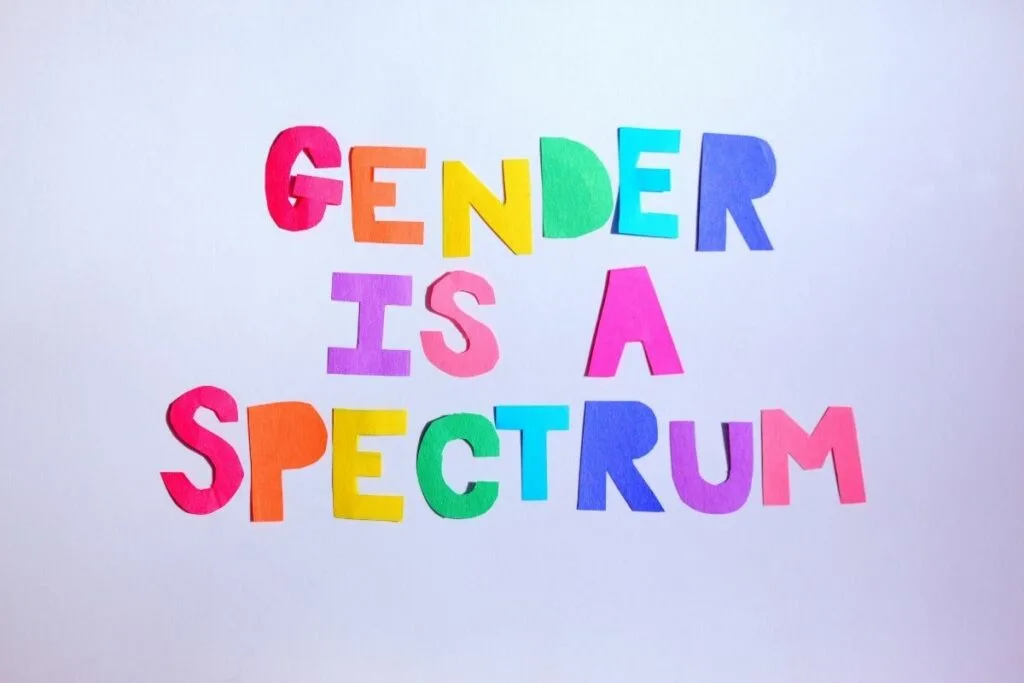More and more people are becoming more accepting of the LGBTQ+ community. And, it’s a good thing. With people being more ‘aware,’ it’s impossible to ignore the new LGBTQ+ terms that describe different genders. Unfortunately, some of the new terms appear almost similar and can be confusing for anyone who doesn’t know how to differentiate them.
Case in point: bigender vs. genderfluid!
We have previously helped explain Genderfluid vs. Genderqueer, Genderfluid Vs. Non-Binary and Agender Vs. Genderfluid and now we will explain what it means to be bigender vs. genderfluid and how these two terms differ.
If you are a bigender, we hope that the information we give here can help you explain to your family and friends what the term describing your gender means and how it’s different and unique from others.
What Is Bigender?
Bigender people identify with exactly two genders, either simultaneously or varying between the two. Here’s an easy way of explaining it. Take a moment and imagine the spectrum of gender. On the far left, you have cis males (biological males that identify with the gender assigned to them at birth). On the far right, there are cis females (biological females that identify with the gender assigned to them at birth). In the middle of these two ends, some people identify with ‘in-between’ genders.
Now, some genders don’t necessarily fall within this binary. These genders are known as non-binary genders. The term non-binary is an umbrella term for individuals who don’t exclusively identify as female, male, or other genders within the spectrum. An individual who does not identify as any gender within the spectrum may be genderless, agender, or neutrosis. These three genders are all under the non-binary umbrella.
Bigender people fall under the non-binary umbrella. They experience two genders but aren’t limited to the female or male genders. Bigender can be a combination of two genders within or out of the gender spectrum. When one experiences more than two genders, they are trigender.

Bigender individuals have different ways of expressing their gender. Some of them may engage as drag kings or drag queens since this allows them to be expressive of both the genders they relate to. But, it would be best if you remembered that not everyone that partakes in drag and cross-dressing is bigender.
Cisgender people may sometimes cross-dress if it’s their hobby or interest. Bigender people use different pronouns. If they feel they identify with ‘she/her’ pronouns at one time, those are the pronouns they will use. If they are dressed in male clothing, they might choose ‘he/him pronouns. If the second gender they identify with is non-binary, they might choose ‘they/them/their’ pronouns.
Other bigender people aren’t specific about their gender pronouns due to their dual gender. The term bigender literally means two genders. It can also be used interchangeably with double gender. Bigender individuals may experience their two genders at different times or simultaneously. Bigender people can also identify as transgender.
If a bigender person feels that their gender may change depending on the circumstance or fluctuate over time, they can identify as genderfluid. A genderfluid person is one whose gender identity fluctuates over time. Some bigender people may adopt an androgynous presentation or choose either male or female depending on what they relate to most at a given time. It isn’t uncommon for bigender people to experience body dysphoria.
They may experience body dysphoria at different times of their lives. Keep in mind that gender isn’t the same as sexuality. As such, bigender shouldn’t be confused with bisexual, and dating a bisexual or transgender is not the same as dating a bigender.

Signs You Might Be Bigender
There’s no set of rules to determine how you should be bigender or a test you can do to confirm your gender identity. However, there are some signs you can look out for when questioning whether or not you may be bi-gender. Have a look:
– You don’t always relate to the sex assigned at birth: you might feel more female today and then feel more male tomorrow. Sometimes, you may not be comfortable when someone makes an assumption of your gender, or they use pronouns you were assigned at birth.
– You dress in both masculine and feminine clothes simultaneously: keep in mind that even though you might uniquely express your gender identity, it doesn’t matter. This is who you truly are.
– You’ve experienced gender dysphoria: gender dysphoria is the feeling of discomfort you feel when your biological sex and your gender identity do not match. Gender dysphoria may occur because you’re surrounded by people that have no respect for your identity or because people assume your gender expression.

How Can You Support Your Bigender Partner Or Friend
Other than their gender identity, there’s no other difference between a cisgender person or a bigender person. There’s no reason to discriminate against or treat bigender people differently. Even though some terms are confusing, keep in mind that affirming someone else’s gender identity or respecting someone’s gender identity will not affect your identity.
It’s called being a good human and honestly, it is not hard (though a shocking amount of people still struggle to do this…).
If you’re cisgender, you can support people of other identities or cisgender people by leveraging your cisgender privilege and using pronouns as a normal way of introducing yourself. You can add your pronouns onto your email signatures, social media accounts, or when introducing yourself to people for the first time.
Ensure you apologize any time you misgender anyone and repeat what you were saying while using the right pronouns. Don’t dwell on your mistake or offer lengthy excuses because it puts pressure on the misgendered person to try and comfort you.

What Is Genderfluid?
Genderfluid is an umbrella term describing trigender, multi-gendered, or bigender people who do not identify with one gender. Such people can switch their genders, or their genders fluctuate depending on their feelings or how they’d like to express themselves. Some people can only identify with one gender.
However, for other people, gender identity is a changing phenomenon that is a lot more dynamic. Such people are genderfluid. Put simply; it means that their gender can change. Some genderfluid people identify as transgender. But, not all of them do.
How Genderfluid Is Defined
As we mentioned earlier, genderfluid people are those whose gender fluctuates over time. It may take only an hour, a day, a week, or even months. A genderfluid person might identify as a man one day and a woman the next. Genderfluid people can also identify as bigender, agender, or other non-binary identities.
Changes in some genderfluid people may be extreme, and they might be arbitrary for some.
Genderfluid people may choose to change their gender expression or not to change it after they’ve noticed that their gender identity has changed. For instance, they might change how they present themselves through their pronouns or their dress code, or they might maintain it as it has been. Some genderfluid people may experience the internal shift but might not be ready to express it outwardly.
While some transgender people may feel like they are not in the right body, genderfluid people don’t feel this way. To them, gender is an expansive concept. It has no boundaries, it is fluid, and it can’t be defined. Remember that gender-fluid isn’t a fad.

Throughout history, there are many instances where people were genderfluid but had to hide their identity because they were scared of the stigma and ostracisation they would face if they lived openly. Genderfluidity has nothing to do with one’s sexuality. It doesn’t determine whether one will be pansexual, bi, polyamorous, or straight. The only thing it can do is open up multiple options for you.
We’ve said before that there’s no test for gender identity, and there’s no one way to be a certain gender. But, there are some general signs you can look out for that could tell whether you’re genderfluid. Read on:
- You change your preference in pronouns and titles: when your partner calls you ‘girlfriend’ or ‘boyfriend’ today, you might be ok with it. However, things might change tomorrow, and you might feel like the label is wrong or repulsive to you. Maybe sometimes you love it when your siblings call you ‘brother,’ and other times you just wish they wouldn’t use that word. Maybe in the morning, you felt like a ‘he,’ but right now, you feel like a ‘she.’
- You experience dysphoria but not all the time: dysphoria isn’t exclusive to people that identify as genderfluid. However, it’s pretty common within the community. Dysphoria refers to the discomfort one feels about the gender they were assigned at birth. Dysphoria comes from the Greek word meaning ‘hard to bear.’ Keep in mind that not all trans people have experiences with dysphoria and that it isn’t a marker for being trans.
- You’re uncomfortable identifying as only female or male: take a look at your life right now. How do you feel identifying as only male or female? Do you think you can do it for the rest of your life? If the answer is ‘no,’ maybe you’re genderfluid.
- Explaining your gender identity isn’t something you find easy: you don’t know how to introduce yourself. Are you a boy? No, you feel like a girl. Wait, not anymore, now you don’t identify with either. While the media has portrayed gender-fluid as people that always know what their gender is at all times, they couldn’t be further from the truth. Many gender-fluid usually don’t find it easy to tell their gender at all times. They also find it hard to know what they’d actually want their gender to look like. Being genderfluid can feel like being an actual shapeshifter.
- You’re fascinated by, want to be, or spend time thinking about genderfluidity: consider this- cis individuals don’t obsess about whether they might be a different gender than their birth-assigned gender. They just are. Wanting to be a different gender is a good reason to be it. Maybe that’s just who you’ve always been.
Keep in mind that genderfluid and genderqueer do not mean the same thing, even if they sound similar.

A genderfluid person experiences fluctuations in their gender identity over time, but a genderqueer person’s identity doesn’t change. However, it’s possible to identify both as genderfluid and genderqueer.
Your gender identity and the labels you choose to refer to yourself are ultimately up to you. If you feel the term ‘genderfluid’ is the one that suits you, that’s ok, and you should use it. If how you feel about yourself changes tomorrow, a month from now, or even next week, the most important thing is that you’ve chosen a gender that allows you to feel good about who you are.
We are solely responsible for identifying our genders. In fact, the only way for you to identify your gender is for you to identify it. Please don’t wait for other people to assign you genders you can’t or won’t identify with. Only you can say whether you’re a woman, a man, or any other gender identity.

Recap Of Bigender Vs. Genderfluid
It’s common for people to confuse the terms bigender and genderfluid. One excellent way to differentiate bigender vs. gender-fluid is to think about your identity as being static. While you may identify with two genders simultaneously or one at a time, your feelings do not change.
Even though your gender expression changes, as a bigender, your gender basically stays the same. Learning how to differentiate between gender expression and gender identity is essential when differentiating bigender vs. genderfluid.
If you aren’t sure yet, it’s up to you to figure out and explore the identity that feels right to you. You’re the only one that can tell what’s wrong and what’s right.
No one can decide your identity for you. You’re the only one that can tell whether or not your identity is the right choice for you. Keep in mind that succumbing to pressure won’t do you any good. It’s ok to take time to question who you really are.


